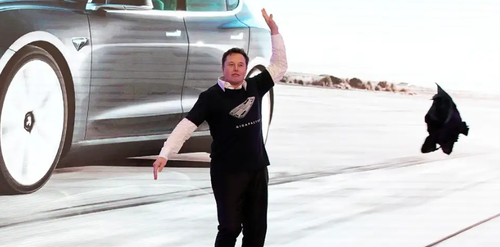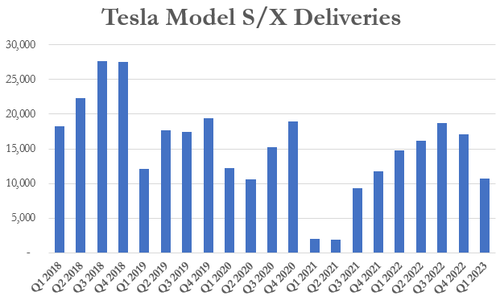
It looks like the bad news could only be getting started for Tesla.
The EV maker, which tumbled nearly 10% to end the week after reporting disappointing earnings and margins that failed to impress the street, is now also starting to lose its stronghold in the state of California, Reuters reported Saturday morning.
The report shows that the company controlled just 59.6% of the battery electric market in California in Q1 2023, which is down from 72.7% in the year prior period. It's also the lowest market share Tesla has had in California since 2017.
Reuters made the calculation using data from the California Energy Commission and found that legacy automakers like Volkswagen, General Motors, Chevy and Kia all expanded their market share in the state, despite still sitting in the single digits, far behind Tesla.
Last year, sales in California accounted for 16% of the company's global deliveries, the report says. It'll be no surprise that the West Coast state is also the largest in the U.S. for zero emission vehicles, making it a necessary stronghold for those who want to compete in EVs in the United States.
Tesla, meanwhile, has been in a back-and-forth with raising and lowering the prices of its vehicles, ostensibly trying to find a "sweet spot" between being able to stoke demand, while not destroying margins any further than it did last quarter.
We noted on Friday that Tesla is now increasing the prices of both versions of its Model S and X electric vehicles. The Model S Plaid and Model X Plaid now cost $107,490 from $104,990 earlier, Reuters wrote. They also said the regular Model X is at $97,940, which marks about a 2.6% rise, and the Model S is at $87,490, marking a rise of about 2.9%.
Shares of the EV maker plunged Thursday after reporting earnings that disappointed Wall Street on Wednesday after market. Among the topics of discussions were the company's poor margins, occurring as a result of Tesla slashing prices consistently since the beginning of 2023. Total GAAP margin for the quarter was 19.3%, missing estimates of 21.2% and down 977 bps from 29.1% just one year ago.
Tesla closed its first quarter with record deliveries hitting over 423,000 units worldwide, but that’s still less than what the automaker produced. Tesla has used price cuts throughout the quarter, aiming to reach more of the mass market, and as Bloomberg calculated earlier this week, the latest price cut makes the Tesla Model Y nearly a third cheaper than it was at the start of the year, in part due to the introduction of a new lowest level trim.
The most recent cuts to Model X and Model S prices came on March 6, a little more than a month ago, when the company reduced the starting prices for the S and X in the US by 5.3% and 9.1%, respectively, to $89,990 and $99,990. Additionally, the higher-performance Plaid version of the Model S and X had been lowered by 4.3% and 8.3%.
Back in March, Musk claimed that demand for Teslas was nearly unlimited and would increase significantly as the company made its vehicles more affordable. The recent price reductions at the time implied that these vehicles may not have had experienced the same boost in demand as the rest of the lineup when the company reduced prices earlier this year. That appeared to be the case when the company reported deliveries at the beginning of April.
It looks like the bad news could only be getting started for Tesla.
The EV maker, which tumbled nearly 10% to end the week after reporting disappointing earnings and margins that failed to impress the street, is now also starting to lose its stronghold in the state of California, Reuters reported Saturday morning.
The report shows that the company controlled just 59.6% of the battery electric market in California in Q1 2023, which is down from 72.7% in the year prior period. It’s also the lowest market share Tesla has had in California since 2017.
Reuters made the calculation using data from the California Energy Commission and found that legacy automakers like Volkswagen, General Motors, Chevy and Kia all expanded their market share in the state, despite still sitting in the single digits, far behind Tesla.
Last year, sales in California accounted for 16% of the company’s global deliveries, the report says. It’ll be no surprise that the West Coast state is also the largest in the U.S. for zero emission vehicles, making it a necessary stronghold for those who want to compete in EVs in the United States.
Tesla, meanwhile, has been in a back-and-forth with raising and lowering the prices of its vehicles, ostensibly trying to find a “sweet spot” between being able to stoke demand, while not destroying margins any further than it did last quarter.
We noted on Friday that Tesla is now increasing the prices of both versions of its Model S and X electric vehicles. The Model S Plaid and Model X Plaid now cost $107,490 from $104,990 earlier, Reuters wrote. They also said the regular Model X is at $97,940, which marks about a 2.6% rise, and the Model S is at $87,490, marking a rise of about 2.9%.
Shares of the EV maker plunged Thursday after reporting earnings that disappointed Wall Street on Wednesday after market. Among the topics of discussions were the company’s poor margins, occurring as a result of Tesla slashing prices consistently since the beginning of 2023. Total GAAP margin for the quarter was 19.3%, missing estimates of 21.2% and down 977 bps from 29.1% just one year ago.
Tesla closed its first quarter with record deliveries hitting over 423,000 units worldwide, but that’s still less than what the automaker produced. Tesla has used price cuts throughout the quarter, aiming to reach more of the mass market, and as Bloomberg calculated earlier this week, the latest price cut makes the Tesla Model Y nearly a third cheaper than it was at the start of the year, in part due to the introduction of a new lowest level trim.
The most recent cuts to Model X and Model S prices came on March 6, a little more than a month ago, when the company reduced the starting prices for the S and X in the US by 5.3% and 9.1%, respectively, to $89,990 and $99,990. Additionally, the higher-performance Plaid version of the Model S and X had been lowered by 4.3% and 8.3%.
Back in March, Musk claimed that demand for Teslas was nearly unlimited and would increase significantly as the company made its vehicles more affordable. The recent price reductions at the time implied that these vehicles may not have had experienced the same boost in demand as the rest of the lineup when the company reduced prices earlier this year. That appeared to be the case when the company reported deliveries at the beginning of April.
Loading…





